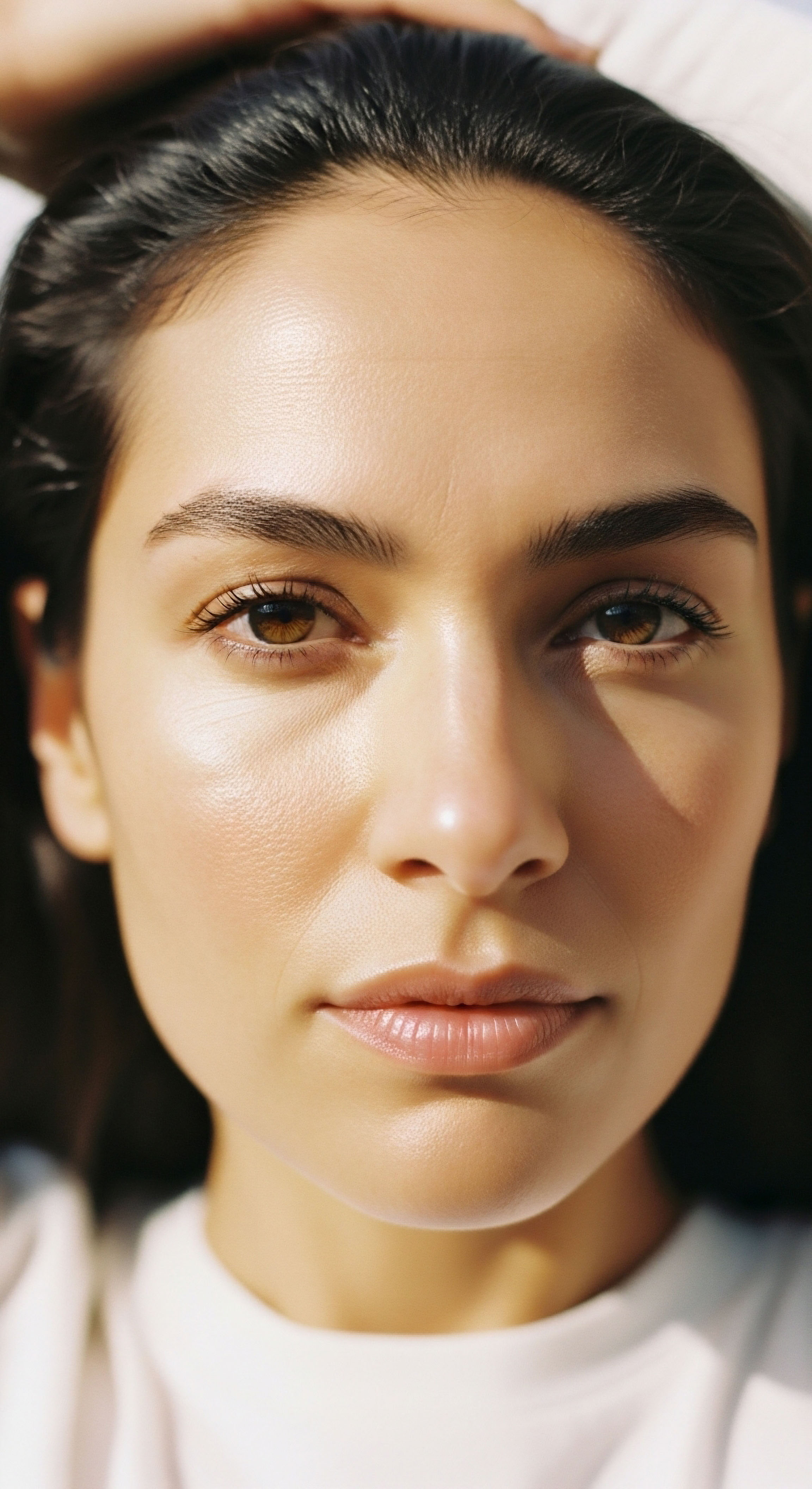

Fundamentals
Observing subtle shifts in your facial appearance can be a deeply personal experience. Perhaps you notice a diminished plumpness, a less vibrant complexion, or a softening of contours that once defined your visage. These visible changes often prompt questions about what is truly happening within your body, extending beyond superficial concerns to a deeper inquiry about vitality and biological function.
It is a natural human response to seek understanding when your reflection no longer aligns with your internal sense of self.
The aging process, particularly as it manifests in the face, is not merely a surface phenomenon. It represents a complex interplay of internal biological systems, with hormonal fluctuations playing a significant, often underestimated, role. Your skin, the largest organ, acts as a mirror reflecting the intricate dance of biochemical messengers circulating throughout your system.
A decline in certain hormone levels can directly influence the structural integrity and regenerative capacity of dermal tissues, leading to changes in elasticity, hydration, and overall skin quality.
Visible facial changes often signal deeper shifts in the body’s internal hormonal balance and biological function.

The Endocrine System and Skin Health
The endocrine system, a network of glands producing and releasing hormones, orchestrates nearly every bodily process, including those responsible for maintaining youthful skin. Hormones act as chemical signals, transmitting instructions to cells and tissues. When these signals diminish or become imbalanced, the cellular machinery responsible for skin repair and maintenance can slow down. This systemic slowdown contributes to the visible signs of aging that concern many individuals.
Consider the role of specific hormones in maintaining skin’s youthful characteristics. Estrogen, for instance, plays a vital part in preserving skin hydration, thickness, and collagen content, particularly in women. As estrogen levels decline during perimenopause and menopause, women frequently report increased skin dryness, reduced elasticity, and the appearance of fine lines and wrinkles. Similarly, testosterone influences skin thickness, sebum production, and collagen synthesis in both men and women. A reduction in testosterone can contribute to thinner, less resilient skin.

Collagen and Elastin Production
Two structural proteins, collagen and elastin, provide the skin with its firmness, strength, and flexibility. Collagen fibers give skin its plumpness and resistance to stretching, while elastin fibers allow it to snap back into place after being stretched. Hormones significantly influence the production and degradation rates of these proteins.
A decrease in certain hormone levels can accelerate the breakdown of existing collagen and elastin while simultaneously slowing down the creation of new fibers. This imbalance leads to a gradual loss of skin integrity, resulting in sagging, wrinkles, and a less supple appearance.
Beyond structural proteins, hormones also impact the skin’s ability to retain moisture. Adequate hydration is paramount for a healthy, radiant complexion. Hormonal shifts can compromise the skin’s barrier function, leading to increased transepidermal water loss and chronic dryness. This dryness not only feels uncomfortable but also accentuates the appearance of fine lines and contributes to a duller complexion. Understanding these foundational biological connections provides a clearer perspective on how internal hormonal states translate into external facial characteristics.


Intermediate
Addressing the visible aspects of aging often requires looking beyond topical solutions to the underlying biological drivers. Hormonal optimization protocols, frequently referred to as hormone replacement therapy (HRT), represent a targeted strategy to recalibrate the body’s internal messaging system.
These protocols aim to restore hormone levels to a more youthful physiological range, thereby influencing cellular processes that contribute to skin health and facial appearance. The approach is not about reversing time but about restoring optimal function to biological systems that have become less efficient with age.
The mechanisms by which hormonal support influences facial aesthetics are multifaceted. They involve direct effects on skin cells, alterations in subcutaneous fat distribution, and improvements in overall metabolic health. When considering hormonal support, it is important to understand the specific agents and their intended actions within the body.
Hormonal optimization protocols work by recalibrating internal systems, influencing skin health and facial appearance through direct cellular effects and metabolic improvements.

Testosterone Optimization for Skin Vitality
Testosterone, often associated with male physiology, plays a significant role in skin health for both sexes. In men experiencing symptoms of low testosterone, known as andropause, a structured Testosterone Replacement Therapy (TRT) protocol can yield noticeable improvements. The standard approach frequently involves weekly intramuscular injections of Testosterone Cypionate (typically 200mg/ml). This administration method ensures consistent systemic levels, supporting various bodily functions, including dermal integrity.
To maintain the body’s natural testosterone production and preserve fertility, men on TRT often receive concomitant medications. Gonadorelin, administered via subcutaneous injections twice weekly, stimulates the pituitary gland to release luteinizing hormone (LH) and follicle-stimulating hormone (FSH), which are essential for testicular function.
Additionally, Anastrozole, an oral tablet taken twice weekly, helps manage the conversion of testosterone to estrogen, mitigating potential side effects such as fluid retention or gynecomastia. Some protocols also incorporate Enclomiphene to further support LH and FSH levels, promoting endogenous testosterone synthesis. These combined strategies aim for a balanced hormonal environment that supports overall well-being, including skin resilience.

Female Hormonal Balance and Facial Appearance
For women, hormonal changes during peri-menopause and post-menopause can significantly impact skin quality. Protocols for women often involve a precise application of testosterone and progesterone. Testosterone Cypionate, typically administered weekly via subcutaneous injection at a low dose (10 ∞ 20 units or 0.1 ∞ 0.2ml), can enhance skin thickness, collagen density, and libido. The dosage is carefully titrated to avoid virilizing effects while still providing systemic benefits.
Progesterone is prescribed based on a woman’s menopausal status, playing a crucial role in balancing estrogen and supporting skin elasticity and hydration. Another option for long-acting testosterone delivery is pellet therapy, where small pellets are inserted subcutaneously, releasing a steady dose over several months.
When appropriate, Anastrozole may also be used in women to manage estrogen levels, particularly in cases where testosterone conversion is a concern. These tailored approaches seek to restore a hormonal equilibrium that supports skin health and a more youthful facial appearance.

Growth Hormone Peptide Therapy and Skin Rejuvenation
Beyond traditional hormonal support, specific peptide therapies are gaining recognition for their regenerative properties, particularly in active adults and athletes seeking anti-aging benefits. These peptides stimulate the body’s natural production of growth hormone (GH), which plays a direct role in cellular repair, collagen synthesis, and metabolic regulation.
Key peptides utilized in these protocols include ∞
- Sermorelin ∞ A growth hormone-releasing hormone (GHRH) analog that stimulates the pituitary gland to secrete GH. This can lead to improved skin elasticity and reduced wrinkling.
- Ipamorelin / CJC-1295 ∞ A combination that also acts on the pituitary to increase GH secretion.
This pairing is often favored for its sustained release and minimal impact on cortisol levels, contributing to better skin tone and tissue repair.
- Tesamorelin ∞ A GHRH analog specifically approved for reducing visceral fat, which can indirectly improve facial contours by reducing overall adiposity and improving metabolic health.
- Hexarelin ∞ A potent GH secretagogue that can promote cellular regeneration and collagen production, offering benefits for skin integrity.
- MK-677 ∞ An oral growth hormone secretagogue that increases GH and IGF-1 levels, supporting muscle gain, fat loss, and potentially enhancing skin quality and sleep.
These peptides work by signaling the pituitary gland to release GH in a pulsatile, physiological manner, mimicking the body’s natural rhythm. The subsequent increase in GH and Insulin-like Growth Factor 1 (IGF-1) promotes protein synthesis, cellular proliferation, and tissue repair, all of which contribute to healthier, more resilient skin and a more vibrant facial appearance.
Consider the following comparison of hormonal agents and their primary effects on skin and facial appearance:
| Hormonal Agent | Primary Mechanism of Action | Potential Facial Aesthetic Benefits |
|---|---|---|
| Testosterone | Stimulates collagen synthesis, increases skin thickness, influences sebum production. | Improved skin firmness, reduced fine lines, healthier complexion. |
| Progesterone | Supports skin elasticity, hydration, and collagen production; balances estrogen effects. | Enhanced skin suppleness, better moisture retention, reduced dryness. |
| Sermorelin/Ipamorelin | Stimulates natural growth hormone release, promoting cellular repair and protein synthesis. | Increased skin elasticity, reduced wrinkles, improved overall skin texture. |
| Anastrozole | Aromatase inhibitor, reduces estrogen conversion from testosterone. | Helps prevent fluid retention and puffiness, maintaining facial definition. |
The precise application of these agents, guided by clinical assessment and laboratory markers, represents a sophisticated approach to supporting the body’s intrinsic capacity for regeneration and maintaining a more youthful appearance.


Academic
The question of whether hormonal optimization protocols can influence the visible signs of facial aging extends into the intricate molecular and cellular mechanisms governing dermal integrity. From an academic perspective, the impact of hormones on facial appearance is not merely anecdotal; it is grounded in the complex interplay of endocrine axes, cellular signaling pathways, and extracellular matrix dynamics. Understanding these deep biological connections provides a scientific basis for the observed aesthetic improvements.
The skin’s structural components, primarily collagen and elastin, are synthesized by specialized cells called fibroblasts within the dermis. These fibroblasts possess receptors for various hormones, including androgens (like testosterone) and estrogens. Hormonal fluctuations directly influence fibroblast activity, impacting the rate of collagen and elastin production, as well as the expression of enzymes that degrade these proteins, such as matrix metalloproteinases (MMPs).
A decline in circulating sex hormones can shift this delicate balance, favoring degradation over synthesis, leading to reduced dermal thickness and elasticity, hallmarks of facial aging.
Hormones directly influence skin fibroblast activity, impacting collagen and elastin balance, which is key to facial youthfulness.

The Hypothalamic-Pituitary-Gonadal Axis and Dermal Health
The Hypothalamic-Pituitary-Gonadal (HPG) axis orchestrates the production of sex hormones. The hypothalamus releases gonadotropin-releasing hormone (GnRH), which stimulates the pituitary gland to secrete LH and FSH. These gonadotropins then act on the gonads (testes in men, ovaries in women) to produce testosterone, estrogen, and progesterone. A decline in the signaling efficiency along this axis, often seen with chronological aging, results in lower systemic levels of these hormones.
For instance, studies indicate that androgen receptors are present in human dermal fibroblasts and keratinocytes. Testosterone, through its interaction with these receptors, stimulates the proliferation of fibroblasts and enhances their capacity to produce collagen type I and III, the predominant collagen types in skin.
This direct cellular effect contributes to increased dermal thickness and improved skin elasticity. Similarly, estrogen receptors are widely distributed throughout the skin, and estrogen’s presence supports hyaluronic acid synthesis, which is critical for skin hydration and plumpness. The reduction in these hormones leads to decreased fibroblast activity, reduced collagen density, and diminished hydration, contributing to facial sagging and wrinkling.

Growth Hormone Axis and Tissue Regeneration
The Growth Hormone (GH) axis, comprising growth hormone-releasing hormone (GHRH) from the hypothalamus, GH from the pituitary, and Insulin-like Growth Factor 1 (IGF-1) from the liver, also plays a profound role in tissue regeneration and repair. GH and IGF-1 are potent anabolic agents, promoting protein synthesis and cellular proliferation across various tissues, including the skin. Age-related decline in GH secretion, known as somatopause, contributes to reduced cellular turnover and impaired wound healing, both of which accelerate skin aging.
Peptides like Sermorelin and Ipamorelin / CJC-1295 work by stimulating the pituitary’s natural, pulsatile release of GH. This physiological increase in GH and subsequent IGF-1 levels directly impacts dermal fibroblasts, enhancing their synthetic capacity. Research has shown that GH and IGF-1 can promote the synthesis of extracellular matrix components, improve skin elasticity, and reduce wrinkle depth. The effect is not merely cosmetic; it reflects a restoration of cellular vigor and regenerative potential within the dermal layers.

Metabolic Pathways and Facial Contours
Beyond direct hormonal effects on skin cells, hormonal balance influences broader metabolic pathways that impact facial contours and overall appearance. For example, sex hormones and growth hormone influence fat distribution. A decline in testosterone in men can lead to increased visceral adiposity, while estrogen decline in women can alter fat distribution patterns, sometimes leading to a less defined facial structure.
Growth hormone, particularly Tesamorelin, is known for its lipolytic effects, specifically targeting visceral fat. Reducing overall adiposity and improving metabolic health can indirectly contribute to a leaner, more defined facial appearance.
Inflammation and oxidative stress are also significant contributors to skin aging. Hormonal imbalances can exacerbate these processes. For instance, low testosterone has been linked to increased systemic inflammation. By restoring hormonal balance, these protocols can help mitigate chronic low-grade inflammation and oxidative damage, thereby preserving cellular health and delaying the degradation of collagen and elastin. This systemic anti-inflammatory effect contributes to a healthier, more resilient skin barrier and a reduction in visible signs of aging.
Consider the intricate molecular signaling pathways involved:
| Hormone/Peptide | Key Receptor/Pathway | Cellular Impact on Skin | Clinical Outcome for Face |
|---|---|---|---|
| Testosterone | Androgen Receptor (AR) | Increases fibroblast proliferation, collagen I/III synthesis, sebum production. | Improved skin thickness, firmness, reduced fine lines, healthier glow. |
| Estrogen | Estrogen Receptor (ERα, ERβ) | Enhances hyaluronic acid synthesis, water retention, antioxidant defense. | Increased hydration, elasticity, reduced dryness, improved plumpness. |
| Growth Hormone (GH) | GH Receptor (GHR) → IGF-1 | Promotes fibroblast activity, collagen synthesis, cellular regeneration. | Enhanced skin elasticity, reduced wrinkles, improved texture and tone. |
| Progesterone | Progesterone Receptor (PR) | Supports collagen production, anti-inflammatory effects, balances estrogen. | Improved skin suppleness, reduced inflammation, better skin barrier. |

Can Hormonal Recalibration Influence Facial Fat Distribution?
The distribution of subcutaneous fat in the face plays a substantial role in youthful contours. As individuals age, fat pads in the face can diminish or shift, leading to hollowing, sagging, and a less defined jawline. Hormones, particularly sex steroids and growth hormone, influence adipocyte (fat cell) metabolism and distribution.
Testosterone and GH tend to promote a leaner body composition and can influence the maintenance of facial fat pads, contributing to a fuller, more youthful appearance. Conversely, their decline can contribute to fat loss in areas that provide structural support to the face.

What Are the Long-Term Effects of Hormonal Support on Facial Aging?
Long-term studies on hormonal support protocols indicate sustained benefits for skin health and appearance, provided the protocols are managed precisely and consistently. The continuous support of collagen synthesis, cellular regeneration, and hydration mechanisms helps to mitigate the ongoing processes of chronological and photo-aging.
This sustained physiological support aims to slow the rate of dermal degradation and maintain cellular vitality, contributing to a more resilient and youthful facial structure over time. The goal is not a static reversal but a dynamic recalibration that supports the body’s inherent capacity for repair and maintenance.

References
- Rittie, L. & Fisher, G. J. (2002). Ultraviolet light-induced signal cascades and skin aging. Ageing Research Reviews, 1(4), 705-720.
- Thornton, M. J. (2002). The biological actions of androgens in skin. Clinical and Experimental Dermatology, 27(2), 168-174.
- Verdier-Sévrain, S. & Bonté, F. (2007). Skin hydration ∞ a review on its molecular mechanisms. Journal of Cosmetic Dermatology, 6(2), 75-82.
- Baumann, G. (1999). Growth hormone and the skin. Journal of the American Academy of Dermatology, 41(3), 479-482.
- Varma, S. et al. (2018). Testosterone and inflammation ∞ a systematic review. Andrology, 6(5), 700-708.
- Veldhuis, J. D. et al. (2005). Growth hormone and sex steroid interactions in the regulation of body composition. Growth Hormone & IGF Research, 15(1), 1-11.
- Calleja-Agius, J. et al. (2012). The effect of hormone replacement therapy on skin aging. Climacteric, 15(3), 223-230.

Reflection
Considering the intricate connections between your internal hormonal landscape and your external appearance can be a truly illuminating experience. The insights shared here are not simply clinical data points; they represent pathways to understanding your own biological systems more deeply. Your personal health journey is unique, and the knowledge you gain about hormonal influences on vitality and function serves as a powerful starting point.
This understanding prompts a deeper introspection ∞ what steps might you take to support your body’s inherent capacity for balance and regeneration? The information presented is a foundation, inviting you to consider how personalized guidance, tailored to your specific biological markers and lived experiences, could help you reclaim a sense of vibrancy and well-being. Your path toward optimal health is a continuous exploration, and each piece of knowledge acquired strengthens your ability to navigate it with clarity and purpose.



